Big
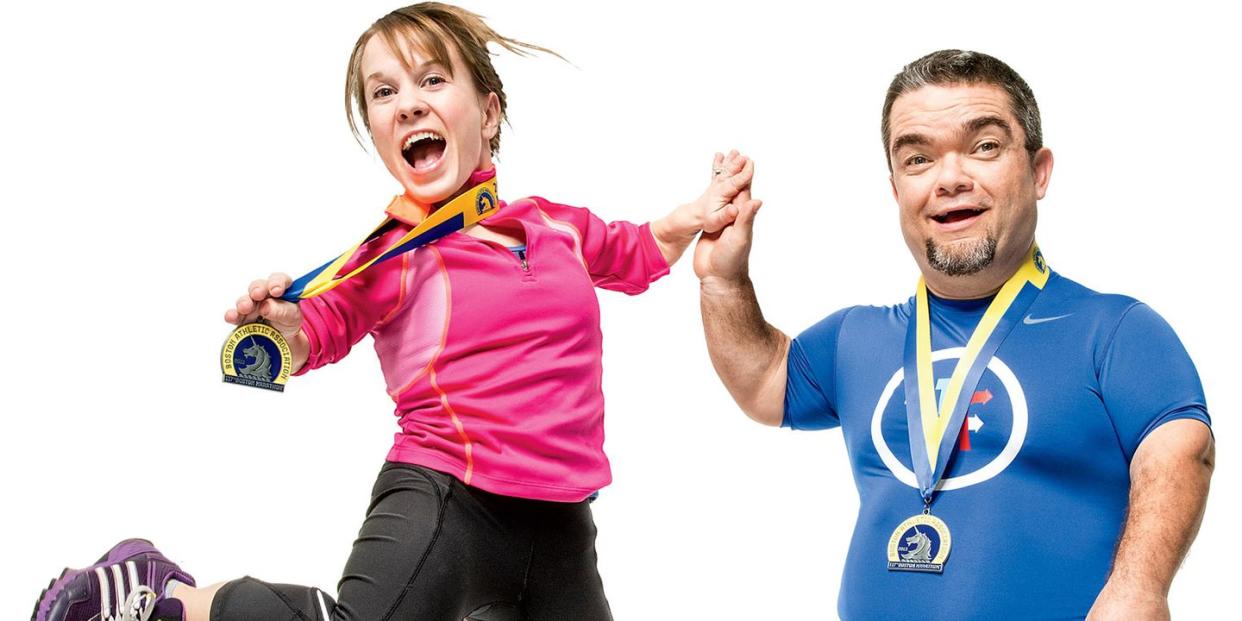
She runs down Beacon Street knowing he is not far away. Seconds ago someone in the crowd had called out to her, alerting her that he was just ahead. For hours, and for nearly 25 miles, she had trailed him, though to say she was chasing him isn’t fair. They were both racing after something, not against someone. He just happened to have had a nearly two-hour head start.
She sees him. He’s easy to spot from her vantage point amid the moving knot of bodies getting closer and closer to Boston’s Back Bay. He’s wearing a white, long-sleeve technical shirt under a yellow racing T. He runs with a waddle, sort of like the Penguin in the old Batman TV series. The yellow shirt and the tick-tock, side-to-side gait make him stand out among the runners around him with their wide if weary strides. So does his height. He’s four feet, four inches tall. Still, at three feet, nine inches, she must reach up to tap him on the shoulder when she comes up behind him.
“You’re doing awesome!” she yells out. Then, with her short but muscular legs, she bounds toward Boylston Street and the end of the 2013 Boston Marathon.
When she was a 15-year-old girl in suburban Atlanta, she had written on a sheet of paper a list of life goals. She put down that someday she would like to get her Ph.D. and write a book and adopt a child. Topping the list was running the Boston Marathon. Twenty-six-point-two miles on legs 22 inches long. She wrote that down after having been running for only a year or so, and during that time she had always finished near the back of any pack she raced in. Could you expect anything more? She was a high-schooler who barely rose to the hips of her teammates. Once, on a long run, she measured her stride length versus that of a teammate and discovered that to keep pace she needed three steps for every two her teammate took. But she loved running both track and cross-country, and liked competing, and was pretty fast, and not just for her size. She once ran a 5K in less than 22 minutes. She ran it in a pair of pink sneakers, kids’ size 13.
Now, 11 years later and 26 years old, she still has yet to come close to winning a race against average-size runners, but on this April day, with the sun splashing down on the Boston Marathon course, nothing is going to slow her down, not even her friend in the yellow racing T, the only person among 23,000 runners in the race who can truly appreciate what she is attempting to do.
Growing up in Toronto, that man had known little if anything about the Boston Marathon, so he never gave a thought to running it. No, if things went right, and if he could find the right woman, he just wanted to be a good husband someday. And if he were lucky enough, he would be the best father any son or daughter would ever have.
But run Boston? No, running wasn’t his thing. Not the way he was built-or at least it wasn’t until a doctor told him he was jeopardizing his life, the one with the wife and son he now had, and that he’d better change his ways. On his 4'4" frame, he was packing 195 pounds.
So one day in 2006, at age 40, he picked up a kid’s bicycle, the kind with 20-inch wheels, and started cycling around Salem, Massachusetts, where he now lived. And he started swimming more, something he had learned when he was a preschooler in a program “for the crippled.” Soon he was losing weight and sleeping better, and he started entering swimming and cycling races. Then he thought, Why not triathlons? Why not? Because he didn’t run, that’s why. It wasn’t usually recommended for little people, for dwarfs. Could damage the hips, the knees, and, especially in his case, the spine. Could do more harm than good, as he’d been told since he was a kid.
But he was no longer a kid, he was middle-aged, and he wanted to do triathlons, and you can’t do triathlons unless you run. So he began running.
And now he is on Beacon Street, just over a mile from the finish of the Boston Marathon. He’s been running since 9 a.m. It’s now close to 3 p.m. He will be the first little person-yes, the first dwarf-to run and finish Boston in its 117 years.
Until she comes up and pats him on the shoulder, and keeps on running.
He shouts encouragement, but in the back of his mind he’s wishing she had caught him just a little later, closer to the finish line, and then maybe they could have crossed it together-the first two little people to complete the Boston Marathon. But she’s faster, 20 years younger, and competitive. He lets his wish fade, like his friend who’s now vanishing into the crowd ahead, and he gets back to moving forward.
And then oddly, when he’s run just another quarter mile or so, she reappears.
Wow, he thinks, she really is fast. She’s made it to the finish and is back to bring me in. Then he sees her face.
“What’s wrong?” he asks as she tells him to stop. The two are at mile 25.4.
“The race is over!” she tells him.
“What do you mean, it’s over?”
She tells him what little she knows. “People say there’s been an explosion at the finish,” she says. “We can’t continue.”
And instead of completing the Boston Marathon, John Young and Juli Windsor just wait there, and wonder. Like thousands of other runners around them, their day won’t end as they thought it would-with the medal, with the silver Mylar blanket, with the finish-line hugs from their families and friends. The hugs were going to squeeze away the memories of all the years of being mocked and laughed at and, yes, looked down upon. Now they will not be the first dwarfs to run and finish the most famous marathon in the world. Their chance of making history is stolen.
Or so it seemed to them at the time. The truth is a bit more complicated.
On Matthew Zinni’s computer screen, John Young and Juli Windsor appear as tiny GPS-tracking dots. It’s midafternoon, and in his office in Havelock, North Carolina, Zinni hasn’t stopped watching the progress of these two dots since early in the day, even while doing his job as a data manager for an airplane company. He’s been posting updates of their movements to Facebook. “This is what it must have been like to watch the Apollo missions in the 1960s,” he writes at one point.
Zinni is four feet, four inches tall. “I’m the only little person in the county,” he says. “I take that back-I’m married to one.” But he is the only little person who runs. Going into the new year, he wanted to lose weight so he could feel more energetic. He suffers from sleep apnea, like a lot of dwarfs. “When I started running, my resting heart rate was 82 beats a minute,” he says. “Now it’s 66 beats a minute. It’s been really good for my health.”
But along the way to becoming a runner, Zinni also heard plenty of catcalls. Teenagers in passing cars would yell, “Hey, check out the midget runner,” as they drove by him while he ran on the roads. The harassment bothered him at first; it doesn’t bother him now, or at least not as much since he went online, googled “dwarf triathlete,” and discovered a runner just as short as he was. He friended John Young on Facebook and told John that he would like to run with him someday. “Everybody who knows me knows about John. He’s my inspiration,” Zinni says.
Just after 3 p.m., the dots on Matthew Zinni’s computer screen stop. They’re together, and not going anywhere. Moments later Zinni messages his friends: “Pray for them.”
On the morning when Juli Anne Erickson was born-March 13, 1987-everything seemed perfectly fine, at least at first glance. The little sister that Jim and Anita’s oldest child, Jaillene, had been praying years for had arrived sporting sparkling hazel eyes and measuring seven pounds, 14 ounces, and 20 inches. Everything seemed quite ordinary. But a staff member who was in the nursery voiced some concern. When she measured Juli, she noticed the baby’s arms were atypically short. Right away, she told the pediatrician that Juli might have dwarfism. The doctor casually mentioned this to Jim and Anita, though he didn’t seem convinced himself that this was the case. Still, a seed had been planted.
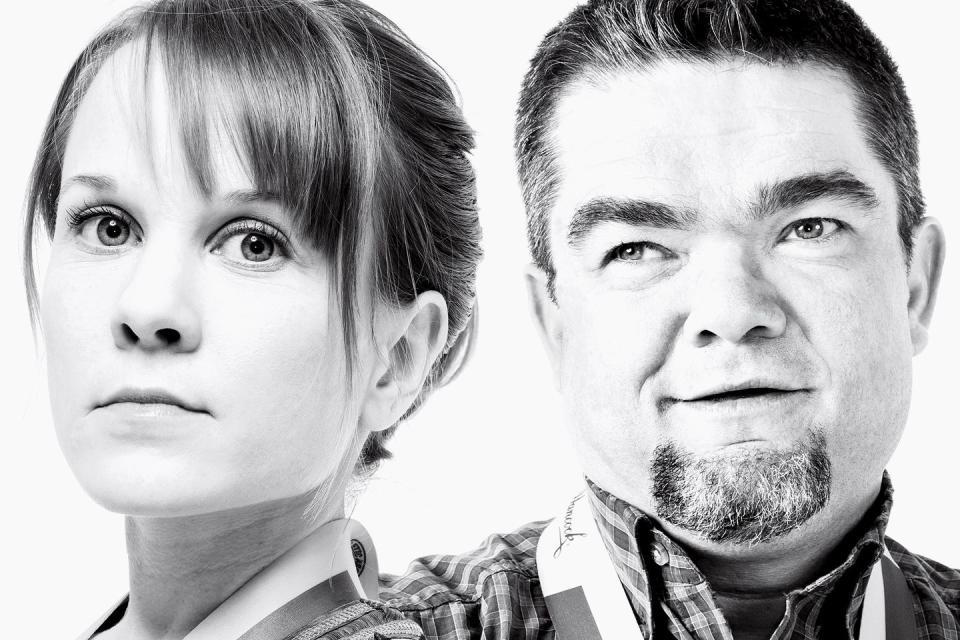
Three years passed, and Jaillene’s little sister was still little, at least for her age. At the playgrounds in Norcross, Georgia, where the Ericksons lived, the other toddlers stood inches taller than she did. They easily maneuvered on the monkey bars. Juli’s hands seemed tinier than the other kids’. She had a hard time grasping the bars, but managed by using her wrists and forearms. On the pediatrician’s growth charts, her numbers continually fell well below the norm. Thinking she might have a pituitary gland problem, Jim and Anita, herself a nurse, took Juli to an endocrinologist. He had X-rays of Juli taken and sent them to other doctors around the country. Quickly, a consensus came back. Juli had no chance of ever reaching the height of her father (5'10") or her mother (5'1") or any of her four siblings. “I thought it was my fault,” Jaillene would confess to her parents years later. “I prayed that I would have a little sister.”
Juli had been diagnosed with one of the rarest forms of skeletal dysplasia-better known as dwarfism-known to science. In fact, she was one in a million.
Dwarfism can be inherited from one or both parents or result from the mutation of a chromosome that’s involved in cartilage and bone growth. Either way, bone development in a person with dwarfism can be severely stunted. There are more than 450 forms of dwarfism, the most common one being achondroplasia. Little people with achondroplasia, like Game of Thrones actor Peter Dinklage, have torsos comparable to those of average-height people; sit down at a table across from an achon and you’ll likely be eyeball to eyeball with him. But once everyone is standing, the dimensions get distorted. The average male achon is little more than four feet, two inches tall, with legs 12 or more inches shorter than the average-size person’s. Often, their legs are bowed, resulting in a waddling gait; for some achons, surgery is necessary to straighten their legs.
But in Juli’s case, both her legs and trunk were short, characteristic of a form of dwarfism called acromesomelic dysplasia. When Juli was diagnosed, there were only 35 reported cases of her condition in the world. Most dwarfs with acromesomelic dysplasia will not even reach four feet. Then there is shortening in the limbs, including the forearms, forelegs, hands, and feet. Juli’s diminutive hands, even with fingers extended, fit in the palms of a five-foot-eight-inch man. She often uses two hands to grasp a glass of water. Her four smaller toes are so tiny that they’re little help with walking or running. Her big toes, in fact, are the only ones that touch the ground.
In order for her form of dwarfism to occur, both parents need the same recessive gene. (With achons, only one parent needs to carry the gene.) Neither of Juli’s parents can recall a relative with severe short stature. But somehow, from some long-ago ancestors on each side of their family, Jim and Anita inherited the blueprints for acromesomelic dysplasia. Years later, Juli arrived.
“We were glad to have her,” says Jim, a minister whose four other children range in height from 5'1" to 5'10". “We treated her like the rest of the children. We taught her that God had a purpose in creating her.”
What that might be would take years, and thousands of small steps, to discover.
And plenty of nightmares, too.
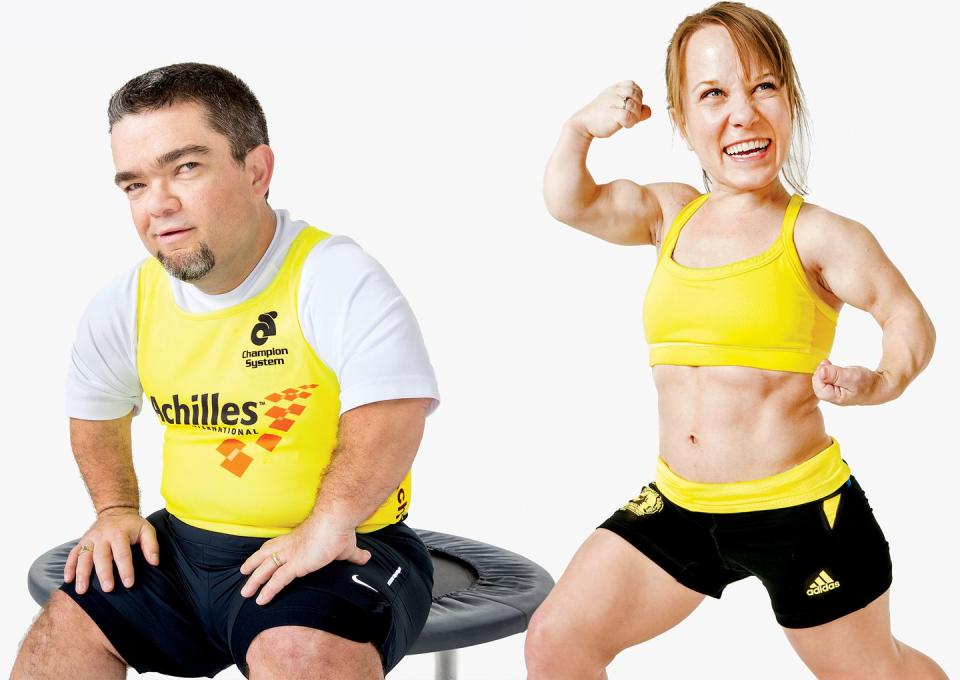
John Young was a Valentine’s Day baby, his mom will tell you, although that statement needs some unbundling. First, he wasn’t born on Valentine’s Day. And John Young’s mom is not his biological mom.
On the day he was born, January 31, 1966, his birth parents knew they were not going to keep their son. The decision, John would learn years later, was not because they couldn’t handle the thought of raising a dwarf, an achon. No, they were young, unmarried, and not ready to take care of a baby of any kind. But Children’s Aid Society of Toronto knew someone who would be. Bernice Clarke had been fostering children for years, while raising four children of her own. She understood what it was like to care for foster kids, and what it can do to you: make you ache when a child you’ve been raising is suddenly taken away.
So when the woman from Children’s Aid Society called to ask her about taking in John, Bernice warned her, “I don’t want anyone who you’ll come and take away.”
“You know what you’re saying, Bernice?” the woman asked.
“I do.”
She was telling the woman that she wanted a child who the agency had classified as unadoptable. So on Valentine’s Day, John Young, just 14 days old but already labeled, entered Bernice’s life and never left it. “It was a long time before I accepted that he was a dwarf,” she says. “I couldn’t see how they figured that out. He looked quite normal.”
He grew slowly but exuberantly. In their house near Toronto’s Earlscourt neighborhood, little John loved to race around the first floor, so nimble that he would run right underneath Bernice’s dining room table without bending over, until the day when he was about four and he clocked his forehead on the table’s edge. He got up crying and laughing. “I guess I grew!” he yelled to Bernice. His bedroom was on the third floor of the house, and Bernice would hear him making his way up and down the stairs on his pint-size arms and legs, starting at 5 a.m. when he was the first one up in the house. Nothing slowed the kid down.
Still, she had her concerns about what might become of this boy. The only little people she knew of were the ones in the movies and on television, like the Munchkins in The Wizard of Oz or the midget wrestlers on late-night shows. People said dwarfs had low IQs, that their often-protruding foreheads meant something must not be working inside. She wanted only the best for John, but she wasn’t sure how to make that happen.
One day, when she and John were walking through a Toronto subway stop, she spotted a dwarf she recognized from TV. It was Guy Big-at least, that was his stage name-a regular on a Canadian series, The Hilarious House of Frightenstein. Bernice asked him several questions, the one John remembers most clearly being, “How should I raise him?”
Guy Big didn’t hesitate. “Whatever you do,” he told her, “treat him like all your other children.”
So that’s what she did. She made him do the same chores around the house as her others kids did. When he needed something-a glass from a cabinet-he learned not to look for help. So he climbed up on chairs and countertops, using his upper-body strength, knees, and elbows to get what he needed. “We didn’t coddle him and we didn’t cater to him, we just loved him like he was our brother, which he was,” his sister Bonnie says now. “He just became extremely independent, and that was probably the best thing that we ever could have done for him.”
Bernice read books to him endlessly, so when it was time to go off to school, he was ready-even if school wasn’t ready for him. When Bernice went to enroll John for pre-kindergarten at Regal Road Junior Public School, the principal told her that the school might not be the right place for John. “Why not?” Bernice asked. The principal pointed to the stairs. “We have three flights in the school,” she said. Bernice laughed. “He climbs steps like that all day long at home,” she told the principal. John was off to school.
She brought him down to the Lakeshore Swim Club, where Gus Ryder, a legendary Canadian swim coach, was training future Olympians as well as “crippled children” (which is what John says little people were considered in the 1960s). He learned all the strokes. Bernice let him play football with his friends even though, she says, “I was having a fit.” And she’d yell at him if he fought back when someone called him short or, worse, midget. “Ignore him,” she’d say. “You’re better than that.” He listened to her even though he wanted to put his fist through the kid’s front teeth.
He became the manager for his high school football team, he played hockey with his friends, he got good grades throughout school, and he was named valedictorian of his senior class. He became the first of Bernice’s kids to go off to college, where he was also named valedictorian, and would go on to teach high school calculus and statistics because math always came easy to him.
Most of all, he developed a good-natured manner. He had a way of putting people at ease, maybe with a cornball joke-”Hey, I gotta get out of the rain. I’ve shrunk enough already!”-or with a simple friendly smile.
Bernice is 87 now, living on her own in Toronto. John always calls her on Valentine’s Day to say, “Mom, I love you.” Like any mother, she still worries about him, though he is now a husband and a father. And she worries about his running, even though he’s finished dozens of races. It’s understandable. Her little boy wasn’t supposed to run very far.
Brenda Kimery, a physician assistant, stands in front of a computer with her coworkers at the Mayo Clinic in Scottsdale, Arizona. They’re finding out via the Web what’s happening thousands of miles away in Boston. She starts praying that her friend Juli is okay.
Kimery sought Juli out two years ago. She wanted to thank her for being an inspiration and let Juli know she was cheering for her. Kimery, who is 5'7", has run several half marathons and one marathon. Her two older girls run, too. But Kimery wonders about her baby, two-and-a-half-year-old Athena. How much and how far will she be able to run someday? Can a girl with achondroplasia turn into an endurance athlete? “From what I’ve read, to do things that are jarring and wearing on her joints could be difficult,” Kimery says. But she’s also read about Juli, the young woman with dwarfism who was planning to run the Boston Marathon. She’s made copies of the stories she found on Juli as well as other athletic little people. “I want to have a book of clips for Athena to read someday,” Kimery says. “I’m all about what she can do.” Even though Athena has only recently learned to walk.
Juli and Kimery started to email each other, and before long they were friends, or as much as two people can become friends via email and Facebook. And now, with every update she gets via the Web on the bombings in Boston, Kimery is anxious to hear what’s happening with her friend.
At age 5, most little girls go to bed and sleep easily, dreaming of what adventures they might get into tomorrow or the fairy tales they read before bedtime. Many nights that’s what Juli did. She dreamed of Thumbelina, the miniature maiden in the Hans Christian Andersen tale that she saw at the movies. “It was at the age when people get obsessive with superheroes-Batman and Superman. I identified with Thumbelina,” Juli recalls in her soft voice.
But some nights she’d awaken in terror, screaming and crying, desperate over what she was and would always be-short and different. Sure, she understood that what made her different could make her stronger. That God had a plan for her. I get that, Juli told herself. She just couldn’t accept it. This daughter of a minister would lie in bed and whisper, “God, why are you making me go through this? Why can’t I be like everyone else?”
It was rough at that age, when she couldn’t jump as high or run as fast as her friends could; she was always going to be the baby when they played house. Her brothers-even her younger brother, Joseph-could ride their bikes by themselves in the street outside their house, but not Juli. Conversations always took place above her; she was never eye-level with anyone. When you are a little person, she says, “You’re constantly going up and down step stools, you’re climbing up and down things. Just living your life is a workout.” And the frustrations that came with her size built up and produced agonizing screams in the night and meltdowns and door-slammings you might expect from a teenager. Yet she was barely a schoolgirl. “People say middle school is horrible because you’re going through this life change,” she says. “But honestly, I went through that crisis at 6.”
Jaillene told her to keep praying, while Jim put strings on light switches. Juli learned to open the three cabinet drawers under the kitchen countertop and turn them into a stepladder to get a glass up above, and that turned out to be kind of fun. If she needed clothing out of the top-loading washing machine, she learned to climb up and into the machine. That was fun, too. And she kept thinking of Thumbelina, often of the part when the little girl walks off with the prince.
Eventually the anger and fear of a little girl started to fade, and she began to grow in unexpected ways. She started to see all the things she could do, and what to do when people told her she couldn’t do something, or be someone, or run a race like everyone else.
John Young had trouble sleeping, too, but that started when he was older-in his late 30s-living north of Boston with his wife, Sue, and his son, Owen. And when his body wasn’t so little anymore.
He had first met Sue in 1985, at a convention of little people. They had only talked a bit that year, so when he next saw her at another little people meeting nine years later, he didn’t recognize her. As she walked across a dance floor, he nudged a friend, “Who’s that?” The friend said, “Sue Casey, from St. Paul, Minnesota.” “That’s Sue Casey?” John blurted back.
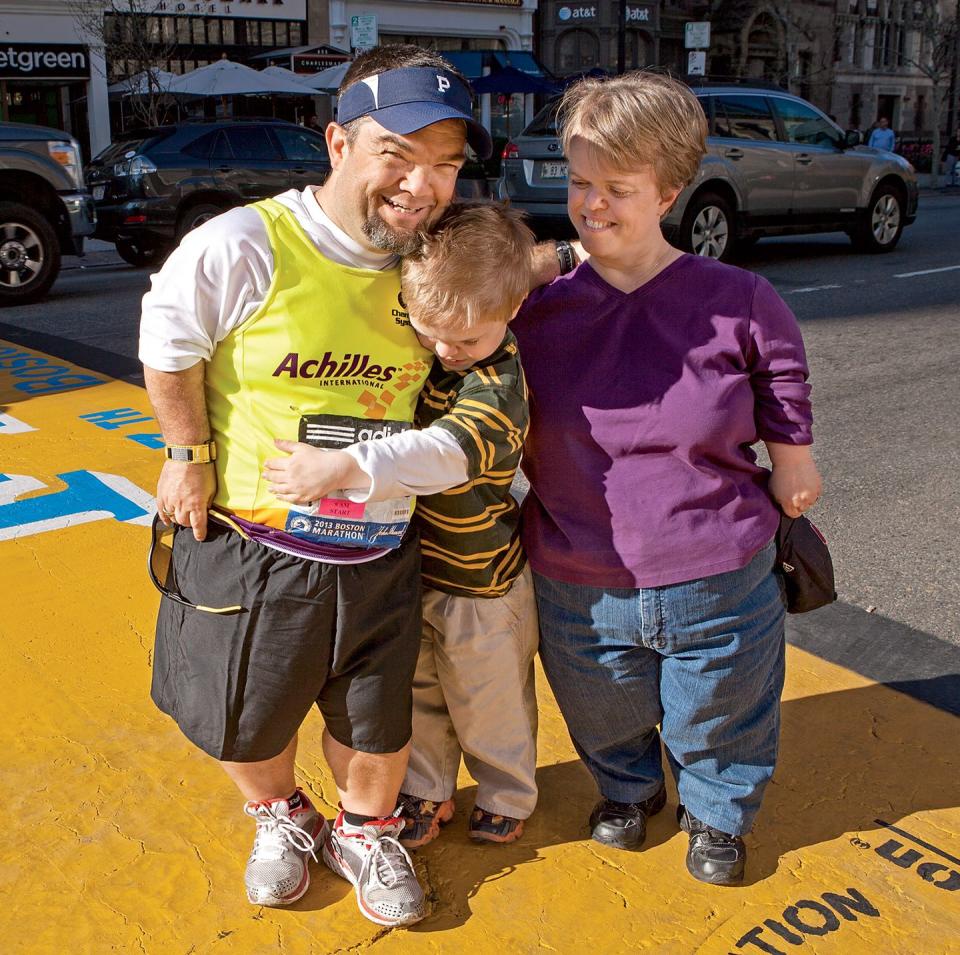
Never shy, John didn’t waste time. He went up to say hello. A few months later they were engaged and soon married. For a time they lived near Toronto, where John had been teaching high school. They moved to Hong Kong for four years, during which time Owen came along. Like his parents, Owen was born with achondroplasia. When they returned from Hong Kong, the family settled in the Boston area, and John eventually found a teaching job at a prep school. He taught upper-level math, coached JV basketball and then the girls’ swim team, did announcing at football games, tutored kids after school. He was always busy. But if he dared to slow down, to just sit down, his eyes quickly got heavy. At faculty meetings, he’d ask a colleague to keep an eye on him. “If I start to doze off, elbow me,” John would say. He had trouble keeping his eyes open driving home from work, and once home, on the living room floor playing with Owen, he routinely fell asleep. At dinner one night, in mid-sentence, he nodded off.
“Did you have a nice nap?” Sue asked with a smile when he finally came to.
But she wasn’t smiling at night, when she could hear his breathing stop for spurts as he slept. After nudging him enough times, she got suspicious. The neurological or structural problems that little people face can often induce sleep apnea. Extra weight is an important factor as well. John, who weighed 150 pounds before getting married, was now close to 200. That additional weight caused his breathing passages to close, sporadically, at night, and his breathing would stop momentarily. Sue made him see a doctor, who recommended a night in a hospital undergoing a sleep study. During the exercise, John’s breathing stopped more than 100 times in one hour. Such occurrences kept him from getting to REM sleep. The therapists suggested he sleep with a CPAP machine; it would blow steady pressurized air through a face mask, letting him breathe more easily while he slept. Within just a few nights, his breathing and sleeping improved, and he awoke more energized.
He decided to get back into swimming, which he hadn’t done since getting married. He also started cycling, using Sue’s Atherton bike with 20-inch wheels to tool around town. He found a cycling club in Salem, and on weekends he’d go off on 20- to 40-mile rides. Within a couple of months he had lost 20 pounds; he started wearing shirts that hadn’t been out of his closet in years. Then, one day at school, he received an email from a friend. Attached was a video clip of Dick and Rick Hoyt, the father-son running and triathlon team. John watched Dick pushing his disabled son in a wheelchair through the Boston Marathon, and carrying him in the waters of an Ironman triathlon.
As John watched the video, a student came into his office. “Why are you crying?” the kid asked. The video had made John think about his son. Owen was only a preschooler but was already dealing with what it was like to be short-statured. He would come home from school and ask his parents, “Why am I always last?” in races with classmates. John hadn’t found the right thing to say. He knew that telling a 4-year-old that he’d be good at something someday wouldn’t help much. The Hoyt video gave him an idea.
He entered an “aquabike” race-a .3-mile swim and a 14-mile bike race-with Owen looking on. “What place did you come in?” Owen asked at the end. “I don’t care,” John said, and then watched as the wheels turned in his son’s head (he had, in fact, finished second to last).
“To me, that was the moment,” John says. “Owen saw someone competing in a race and not caring what place they came in, and-‘It’s my dad. So if my dad doesn’t care…’”
John had started the process of showing his son that size should never hold him back. And now that he was swimming and cycling and losing weight and feeling better, John convinced himself that if the Hoyts could do triathlons, he could, too. So in the summer of 2009, he entered his first event, the Witch City Triathlon in his hometown of Salem. A few days before it he ran the first three miles of his life. Afterward, he hobbled around, and told Sue he wasn’t sure how he was going to make it through the 3.2-mile running segment. He managed to finish the race in 2:12:23, with the run taking him just over 49 minutes, or 16 minutes a mile. How slow he went, or where he finished (in this case, last), didn’t matter. “I got the bug,” he says.
And over the next five years he completed 30 more triathlons as well as a slew of road races, each intended to beef up his triathlon running segment. He did his first half marathon in 2010, and the next year did the first of the three half-Ironmans he’s completed. He started mapping out routes where he could run from his home to his school. A severe heel-striker, he went to a running clinic to improve his form. He put his math skills to work. His inseam is just 16 inches; his stride length almost half that of an average runner. He calculated that he took about 190 steps per minute-about 25 more than the average runner-but because of his short stride length, it took him 2,500 steps to run a mile. “I read where Haile Gebrselassie takes only 900 or so per mile,” he says. Even with all that effort, his back-the body part he most worried about-seemed fine; pain only came when he sat, not when he ran.
People began to notice him. Family members couldn’t believe his weight loss when they saw him on his trips home to Toronto. John got a laugh when a fellow teacher called him the “running guy.” The Hy-Vee Triathlon 5150 U.S. Championships offered John entry into its 2011 race, and he won the disabled person division. (“No one else was in it, but so what?” he confesses.) The Boston Herald wrote about him. Dick Hoyt gave him a bear hug whenever he saw John at a race. Sue warned him, “Be careful-you’ll end up on the cover of a magazine.” He laughed. Then she said, “But we’re not doing any reality TV shows.” And he laughed harder.
It all seemed so much fun, so perfect. He started thinking the unthinkable. I’m an athlete. But then came the night when he googled “midget runner” and “dwarf runner.” It had become his habit. Maybe, John figured, he’d learn about another running little person; he’d never met one or seen one at a race. Too often the search just came back with links to hideous videos of little people racing camels or being chased by drunken fraternity brothers. This time he came across a blog post about him. And when he saw it, he wanted to fire his fist through his laptop.
Headlined “Swim, Bike, Run, Midgets,” the blog was written by a competitor in the same triathlon John had done in New York City in the summer of 2011. The blogger described his race, and then inserted a photo of John with the caption: “My day was brightened considerably by what you see in the picture below. Anybody that knows me, knows I love midgets. Who doesn’t love them? But you simply can’t beat a midget triathlete on a little midget bike. This was priceless!!! I want one of my own someday.”
Over the years John had become almost desensitized to the stares that followed him and Sue and Owen when they went into a restaurant or a movie theater. He had come to expect-if not understand-people’s inclination to pull out a cell phone and sneak a photo. If he heard a young child call out to a parent to “look at the little man,” he would walk over and talk to the child, and explain who he was.
But when ignorance morphed into ridicule or objectification-or both-John couldn’t contain himself. He once mounted a letter-writing campaign urging a chain of New England convenience stores to quit using a little person in a ludicrous way to sell coffee. Other minorities didn’t face such uncensored, insulting treatment, he figured, so why should dwarfs? “There’s still a segment of the population,” John says, “that thinks it’s okay to laugh and point at us.”
John and several racing friends complained to the blogger and demanded that he remove the post. Weeks passed before he did. But even then, John wasn’t going to forget it-just like he’s never forgotten the old man who once told him he’d make an excellent midget wrestler, or the teenage boys who taunted him as he did a training run around Salem. That blog became a permanent memory-and motivation. “It’s the ones who give me grief and make fun of me,” he says. “They get me to the finish line.”
Marilyn Fennell sits at her PC in her condo in Toronto, staring at the screen and trying to figure out why the dots are going backward. Her husband, Fred, is nearby, and since the start of the Boston Marathon, he’s listened as his wife of 42 years gives updates on John’s progress. “I guess they’re being detoured,” she tells him, the dots continuing to go in reverse and away from the finish line.
Fennell was the teacher who took John into her classroom after the principal relented and admitted him to Regal Road School. Fennell taught hundreds of young boys and girls in her 19 years at the school, but John is one of the few with whom she has stayed in touch. She went to his wedding in 1995; he visits her whenever he returns to Toronto to see Bernice. Fennell took an interest in John when he first came to her class, at the time all 2'5" of him. “He needed to be challenged in physical activities,” she remembers. So she taught him to ride a tricycle. And she and Fred took him camping, to give him a taste of nature and to “give Bernice some time off.” She had him reading at a fifth-grade level by the time he left first grade.
Fennell was teaching second grade, years later, when John came back for a visit. He was in high school by then and had grown quite a few more inches. They went for coffee in the cafeteria, and as they did Fennell could hear some of her students giggling, which upset her. Later she asked John, “Do you want to talk to the kids?” He said okay. Around a circle, John told the children about his condition and what might have caused it. But he also pointed out the variety of physical traits, from eye color to hair color, that distinguished each one in the room. He ended by saying to the kids, “We all have different physical characteristics, but we all have feelings.”
Memories like that, Fennell says, make “me feel so honored to have him in my life.”
Now, as she watches the dots on her computer screen, she doesn’t know how to feel. She has no idea what’s happening in Boston. She only knows the dots are not moving in the direction they once were.
When you’re three feet and change, you come to expect obstacles. You just don’t expect them from the woman who got you hooked on Thumbelina.
But in 2002, during the summer after Juli turned 15, she and her mother locked horns over Juli’s desire to compete in the U.S. National Dwarf Games. She had previously taken part in this annual Olympic-style competition for athletes 4'10" and shorter, but in those instances the running events that were offered were no longer than 200 meters. Juli, with two full seasons of track and many hundreds of miles now in her logbook, could not understand why.
She had started running in eighth grade, mostly to stay in step with her friends. And when a bunch of them joined the track team, Juli wanted to follow, though her parents had reservations. She suffered from pain in her lower back, brought on by the severe, half-moon curvature, or lordosis, of her lumbar spine; it’s common among those with her form of dwarfism. Her feet were of concern, too. She pronated excessively. Anita and Jim wondered what harm running might do, “what all this pounding could do to her skeletal system,” Anita recalls.
Juli told her parents not to worry. She even wrote them a letter, pleading that they give her permission to join the team. They relented, but in each of her first few meets, they watched as their little girl, running either the 800 meters or the 1600 meters, came in last.
The results didn’t bother Juli. She thrived on the camaraderie, the pasta dinners before meets, the songs she and her teammates psyched themselves up with. She was losing races, for sure, but not by much. Then one afternoon, in an 800-meter race, she came down the back-stretch, looked back, and saw someone behind her, someone who wasn’t going to catch her. People in the stands could see her smile from 50 yards away. Wait-I just beat someone! she told herself as she crossed the finish line. And that surge of joy felt so good, so addictive, that soon she was asking herself, Who else can I beat? How fast can I go?
That drive set the stage for her showdown with her mother. Early in the summer following her freshman year of high school, Juli had contacted the organizers of the Dwarf Games, requesting that they add the 800 and 1600 meters to their event. The organizers consented, provided that Juli’s high school coach, Andy Martin, approved her entry. Before Martin could give his answer, Anita emailed him. She was worried that doing both races, in succession, could harm Juli. “Coach,” she wrote, “I am thinking that it will be best just to request the 800 meters and not the 1600 meters. Of course, my husband and Juli don’t agree!”
Prior to Juli coming out for the track team, Martin had never met a little person, let alone coached one. He didn’t know what advice to offer Juli or how to make her run any faster. What he could tell, though, was that she had something a lot of other high school runners lacked. “She was used to overcoming things,” he says. “Determination is one quality you don’t have to coach into her. She just has it.”
And in so many words that’s what he emailed back to Juli’s mother: “Anita, I hope that you don’t get angry with me, but I have to agree with Juli. I feel that anytime a person has an opportunity to make history, they shouldn’t hesitate…. Hopefully she can inspire many more people (short or tall) to use their talents and make history also!”
At those Games Juli did make history. She ran the 800 and then the 1600 meters, uncontested. It was the only time the Games featured those events; her times of 3:36 and 7:38 have remained records ever since. Her performance convinced Anita that her daughter was an athlete, just one “in a little body.”
Not long after, Juli put together her wish list of things she wanted to accomplish in life. She topped it with one day running a race longer than any she had ever run before.
For hours, he stood on Boylston Street, waiting for her to run by. But now, with the second bomb having exploded a few yards from where he was standing, he’s worried that he’ll never see his wife again.
Blake Windsor and Juli Erickson had grown up just miles apart in the Atlanta area, but they didn’t meet until they both attended a Little People of America national conference in 2004. Juli had been a regular at these meetings; it was Blake’s first. He had been diagnosed with dwarfism as a child, and had surgeries to correct his bowlegs. Still, standing 4'9", Blake always thought that maybe he was too tall to be considered a little person. He lived in an in-between world.
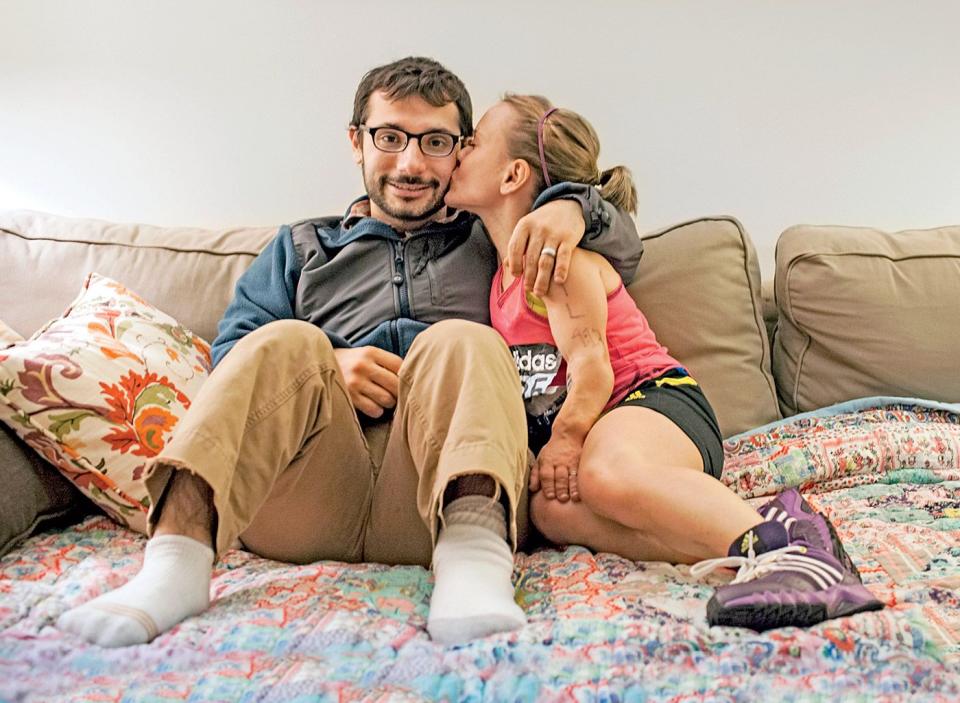
Then he met Juli, and size didn’t matter. The two were in each other’s world. They both liked to travel, they both wanted to go into medicine, and their personalities-the bubbly Juli, the studious Blake-meshed perfectly. “Blake is her tall, dark, and handsome man,” says Juli’s father, Jim, who presided over the wedding ceremony of his daughter and son-in-law in 2009.
They had their differences, of course, most notably: She loved to run; he couldn’t. For him, it’s too painful. “I have bad hips,” he says. “I was always discouraged to run long distances.” He knew how much running meant to her, though. As a medical student studying pain in young children, Blake had opportunities to do his residency at several hospitals around the country. When he placed into his top choice, a joint program between Boston Children’s Hospital and the Boston Medical Center, it meant the couple had to move from their longtime home in the South. Juli was okay with that-it would give her the chance to fulfill her childhood dream of running.
Now, she’s somewhere on the marathon course, their finish-line reunion destroyed moments earlier by an explosion. With the chaos that followed, Blake can’t find either his mother or his mother-in-law, who had been with him. He hears sirens and wonders when the next bomb will go off. He dials his wife’s cell phone and leaves a message. “I’ll always love you,” he tells her.
For years Juli and John had been doing what runners do: going to races, picking up their T-shirts, and checking out the competition.
In the northeast, John, with his happy-go-lucky manner, became a popular fixture at local races. Race directors began inviting him to events. “John is my hero,” says Dave McGillivray, who directs about 30 races a year nationwide, including the Boston Marathon. “He’s my inspiration.” (McGillivray himself is just 5'4".) He drew the attention of Achilles International, an organization that helps disabled athletes participate in mainstream athletics. “When you realize how many more steps he needs,” says Kat Bateman, director of the New York City chapter of Achilles, “it is almost the equivalent of running two marathons.” (John computed the number of estimated steps for him to complete a marathon: 65,000 versus 41,000 for the average runner.) He was slated to run the 2012 New York City Marathon, and would have been the first little person to run that race, until Hurricane Sandy caused the race’s cancelation.
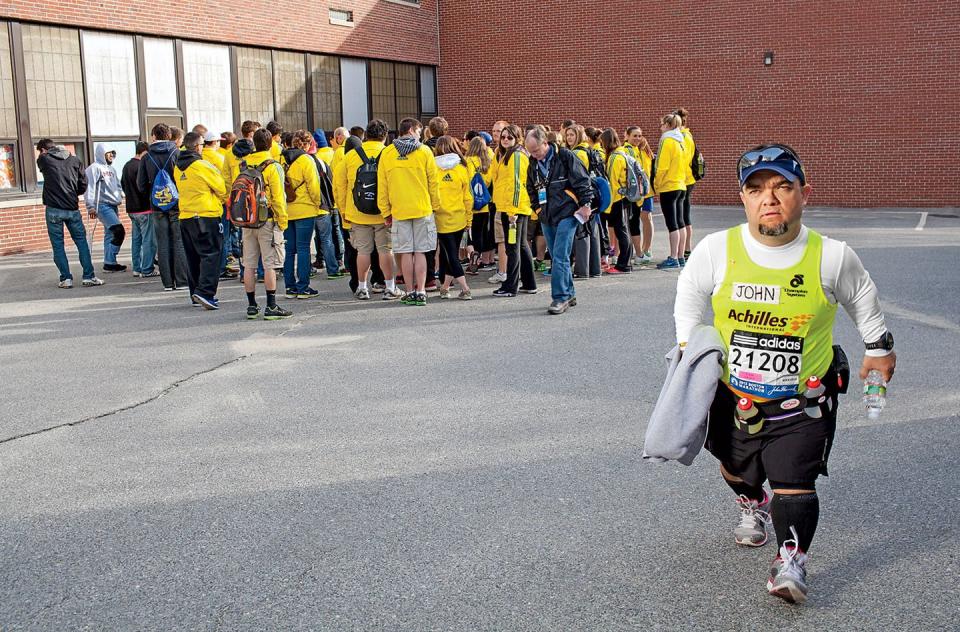
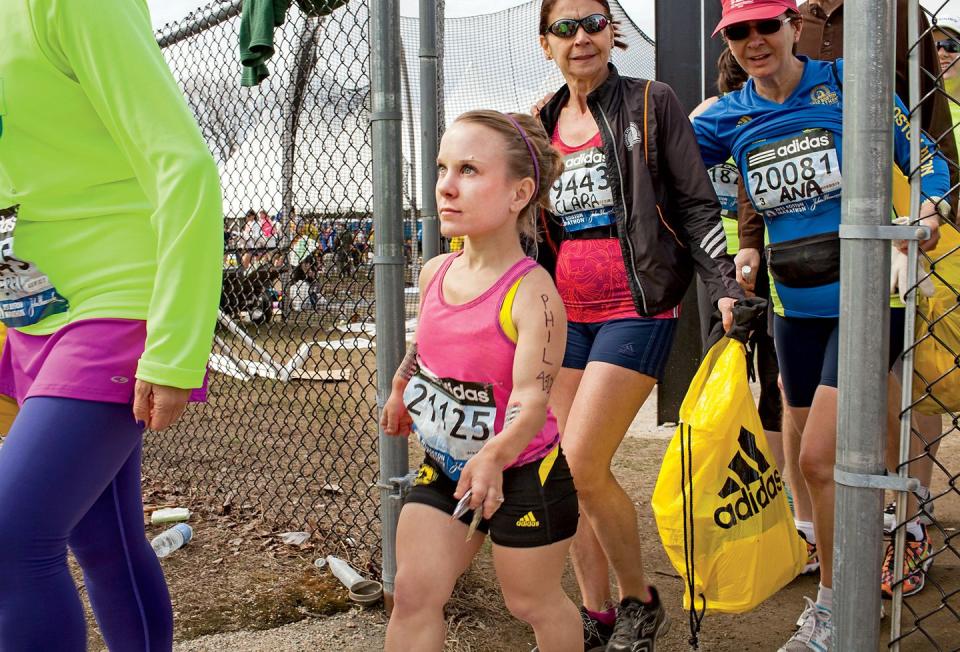
Down South, Juli, after graduating from college and getting married, progressively upped her mileage. She had run one year of cross-country in college and completed several half marathons, but now she set her sights on running her first marathon: Disney in January 2010. Before she got to the starting line, though, she faced an even tougher challenge.
Growing up, she says, she never encountered discrimination. Yes, she got stared at plenty of times, but no one ever kept her from doing something she wanted to try. That changed when she started nursing school in 2009. Six weeks into her first semester, Juli was asked to meet with school officials. They told her they were concerned that she was too small to care for infants. And that the stool she carried with her and used to stand on when attending patients was unsanitary. And that with her short legs, she would be too slow to respond to emergencies. The charges caught Juli by surprise. She had earned better than average grades, she hadn’t even come close to dropping a baby, and she had never been in a clinical setting where she could have been late getting to a patient. Besides, she thought, I plan to run Boston someday. I can’t be slow.
The meeting made her realize she was not welcome in the nursing program. In fact, she was threatened with failure if she continued in it. She left the school that May, eventually entering South University in Savannah, Georgia, seeking an even more challenging degree as a physician assistant. (She graduated last spring with a 3.69 GPA.) With Blake occupied by his med school studies, Juli had time to run and train. And shortly after what she calls “the fiasco at nursing school,” Juli ran the Disney Marathon in 4:56:58. “If you ever want to see me do something,” she said afterward, “tell me that I can’t.”
What she never saw, though, was someone her size to race with, or against. “Never,” she says. “I never encountered another little person who ran.”
That changed in December 2012, shortly after Juli and Blake had moved to Boston. A friend told her about a little person there who ran and did triathlons. She found him on Facebook. “She said, ‘Hey, I’m a runner.’ She was the first little person I’d ever heard of who was,” John recalls.
When they finally met in person, John and Juli talked about their families, their physical conditions, and running, especially their most recent long runs. Both had done fall marathons. After the cancelation of New York, John entered the Myles Standish Marathon and qualified for Boston through its mobility-impaired program. Juli, despite suffering from pneumonia, had run a marathon in Lowell, Massachusetts, in 5:34:04. John told her, “That easily qualifies for Boston.” Days later both were signed up.
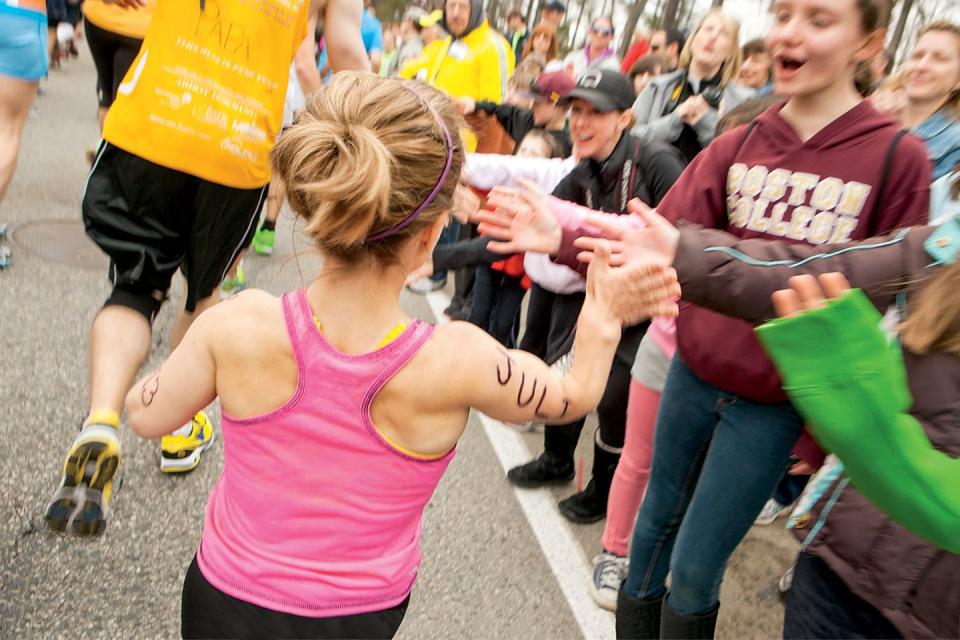
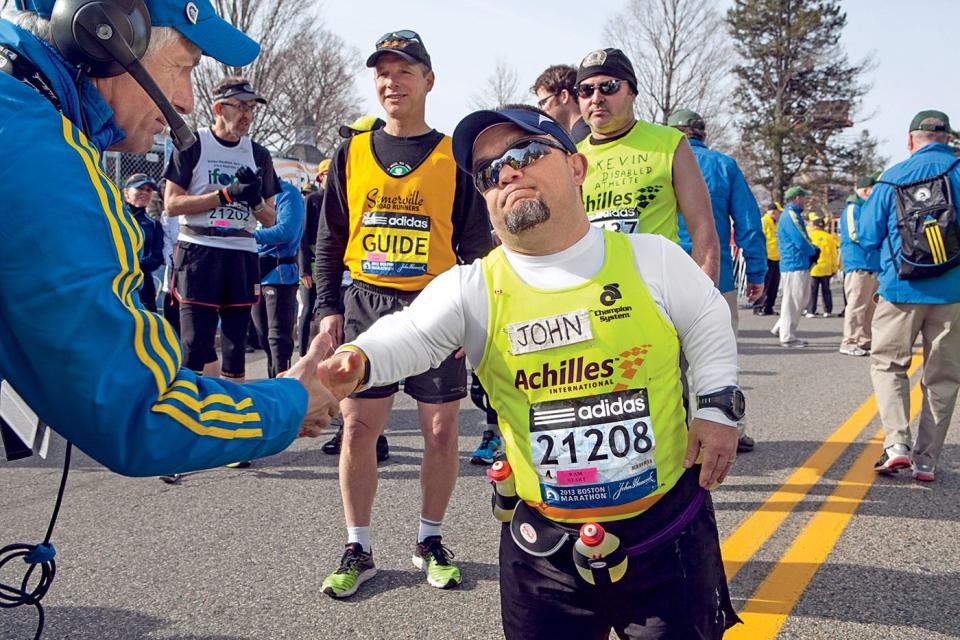
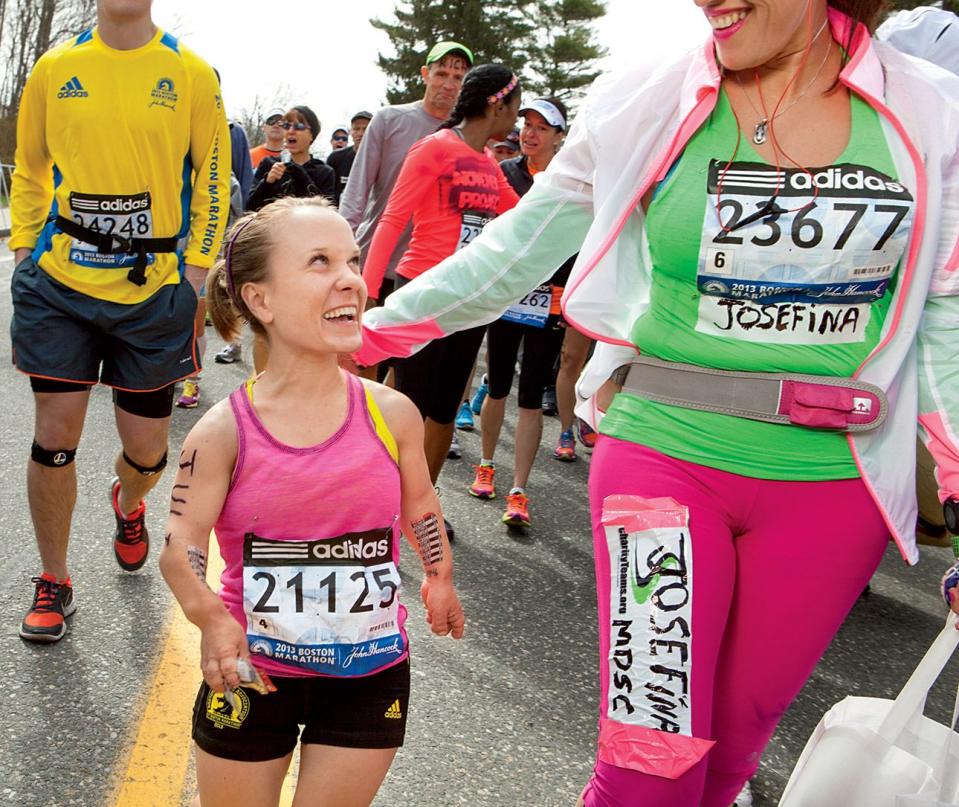
Juli soon joined a running club in Cambridge. Early on she told her coach, Brian Hamill, that she had once run a 5K in 21:21. Hamill did some calculations; based on that time and some consistent training, he told her, she could possibly run a marathon in 3:35-the time able-bodied runners her age need to qualify for Boston. At first she just laughed. “I thought he was crazy,” she remembers. “But it was also encouraging to hear someone say that.” For the upcoming Boston Marathon, Juli and Hamill settled on a goal time of 4:15, which would still mark a 40-minute PR.
John’s Boston time goal was less lofty. He’s a run-walker; for every three minutes he runs, he walks a minute. He planned to start with the group of disabled athletes who went off at 9 a.m., 32 minutes before the elite women, and finish in about six hours. That meant he would take off 1 hour and 50 minutes before Juli, who was racing with the third and final wave of runners. If they both ran the race they were capable of, they’d reach Boylston Street around the same time, just before 3 p.m. Which would set up a climactic finish, of sorts. McGillivray had told John that to his knowledge, no little person had ever finished Boston. Now, at one race, two were entered.
John dampened any thoughts of a rivalry. “I have no doubt in my mind she is going to finish faster than I am,” he said days before the race. “She is 20 years younger than I am. She’s a lot leaner than I am, and she is an experienced runner. She has been doing it all her life.”
Juli, for her part, took a slightly more nuanced view. On the eve of the race, she sat outside a small bakery in Boston’s South End, sipping a cup of tea. She was just hours from attempting the top goal on her life’s wish list; a few months earlier she had found the list among a stack of forgotten papers. As she finished her tea, she was asked if it was possible to make up the difference on John and beat him to the finish. She smiled. Then, “Let’s just say it will be really fun to cross together.” She paused. She smiled again. “I have always sought out competition with another little person. In some ways I have finally found it.”
The TV is turned off in Bernice Clarke’s home. The bombs have exploded, and she can’t watch what might happen next. This is scary, she says to herself. This is terrible.
She lives alone in an apartment outside Toronto. She divorced her husband nearly 40 years ago. “He couldn’t keep up with all the kids,” she says with a chuckle.
Since about 9 a.m. she has been close to the TV, watching the race. Before today she had never seen her son John compete. He would tell her about all the events he had done-the 5Ks, the triathlons, the one previous marathon-and all she would want to know was how long they were. He sent her stories that newspapers had written about him, which she saved. “I’m going to give them to Owen in an album someday,” she says.
On this April day, she saw her son race for the first time. It was a thrill, she says, to see him take off in the first pack of runners. He ran with a list of 26 names that he would use to push him along the way. Number 1 was Sue. Number 6 was the name of the blogger who wanted to have a midget just like him. Number 26.2 was Owen. Number 5 was Bernice.
John was only seven minutes from the finish line when the race was stopped. Bernice doesn’t know where he is. The TV is off. She waits to hear what happened to the boy she took in such a long time ago.
On marathon morning, while a handful of disabled runners who would be getting an early start waited near the starting line in Hopkinton, John had shouted, “It doesn’t matter if it’s a 15-minute mile or a five-minute mile, it’s still a mile!” Then he was off, trying to run 26.2 of them.
And up to the point when Juli catches him, with just a mile or so to go, he is having an “almost perfect day,” sticking to his plan of 13-minute miles. He had run much of the early part of the course by himself, and heard so many cheers. He cheered along when the elite women passed him, with one nodding to him as she ran by. A couple of his former students saw him near Wellesley College, near mile 13, and rushed to give him a kiss. “Everyone,” he’d say later, “should experience a day like that
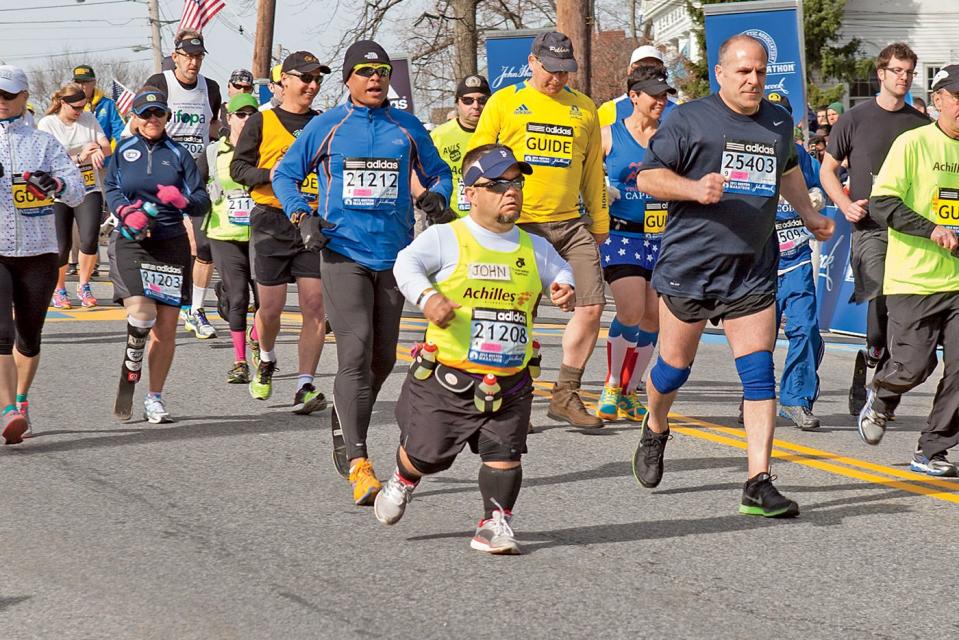
Juli’s day hasn’t been as kind. Minutes before her run began, she had a friend write “4:13” on her left arm. Someone asked if that was her goal time. “No,” she said, “that’s my favorite Bible verse. ‘I can do all things through Christ which strengthens me.’” But early on, the downhills gave her trouble. The continual thumping caused her already deeply curved-in back to compress her lower spine. On training runs she usually didn’t feel much pain until mile 12 or so. Today she was in agony by mile eight.
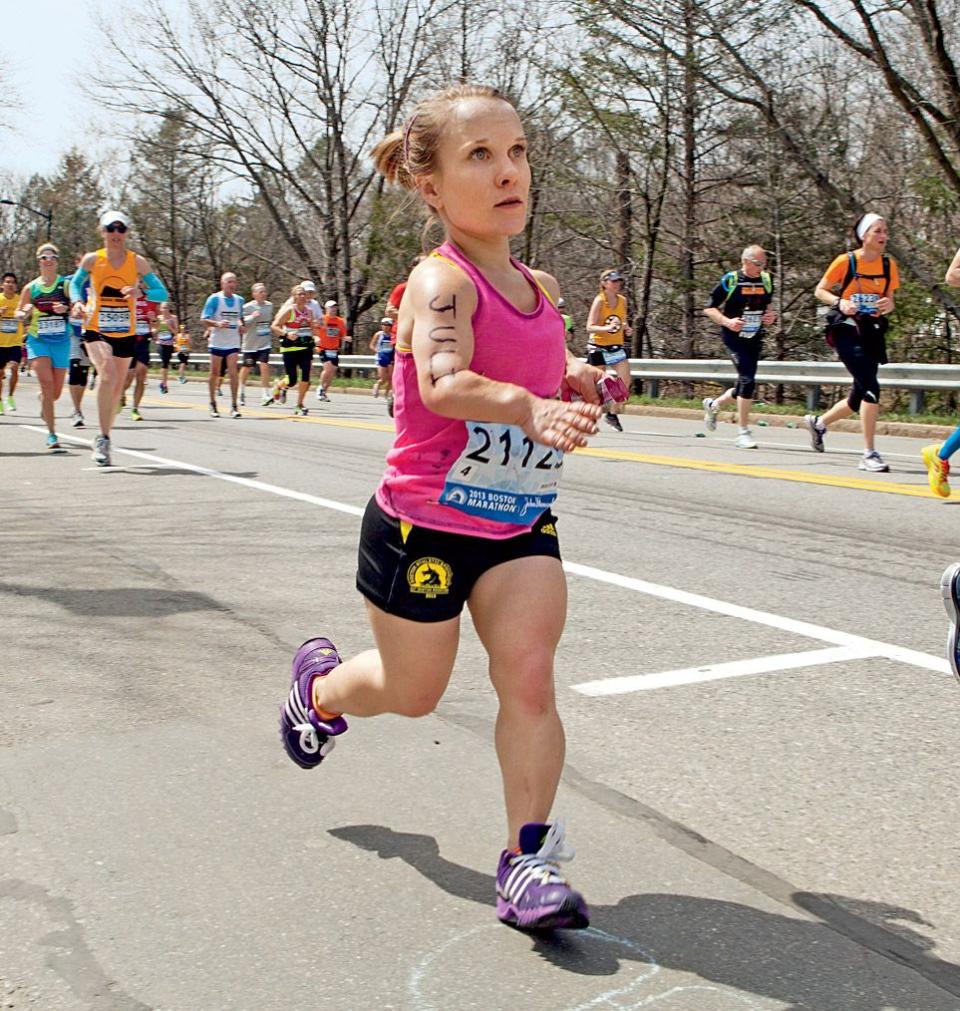
A doctor friend who was also running noticed her and made her stretch and take ibuprofen. The course flattened for several miles, and the crowds pumped her up. She got back to a 9:30-per-mile pace, and even as the back pain began to cause her legs to go numb, she kept running. Toward the end, “I thought, This is going to be mind over matter. I didn’t care about pain.” When she finally passes John, she is on pace to run 4:32, just 17 minutes off her goal time.
And then everything stops, and any pain she feels doesn’t matter anymore.
She goes back and finds John and tells him all that she knows. They’re both stunned. They’ve come this far and now they can’t go any farther. They try to call their families with John’s phone. He reaches Sue, who tells him that she and Owen are safe. The two of them had been in the bleachers, across from where the first bomb went off. They’d escaped the scene through the Boston Public Library and are heading home. John says he’ll get there somehow.
John gives the phone to Juli and she tries to call Blake; there’s no answer.
They walk slowly away from the course and head east with the crowd of runners, toward the Boston Common. In the shadows of downtown, Juli is shivering, and sore. Someone offers her a hoodie. When she puts it on, it falls nearly to her ankles. No matter; it’s warm. A stranger gives John a Mylar blanket. Together, they keep walking.
Juli finally reaches Blake on the phone. It’s been nearly an hour since the explosions. They agree on a meeting spot. He tells her, though, that they’ll have to go to the hospital. Juli’s mom got hurt when she was knocked to the ground by the panicked crowds. It’s nothing too serious, he says, but she’s in a lot of pain. As for him? “I’m okay.” Only later, when she listens to the voicemail he left on her phone-“I’ll always love you”-does Juli realize just how scared he was.
By 4:30, sirens wailing in the chilly air, John and Juli hug and go their separate ways, feeling incomplete, knowing they had both fallen short.
Who could blame them? They understood that their missed chance at history-the opportunity to be first at something-paled against the greater tragedy of the afternoon in Boston. Still, they hurt. John didn’t want to wear the Boston medal that was given out the next day to those competitors who were diverted from the course. “I’ll wear it when I complete the race,” he’d say. Juli would say how not finishing a race is so minor compared with what some people have faced. “I can’t comprehend what that is like,” she’ll say of the three lives lost, and the hundreds of people injured, waiting for runners like her to come down Boylston Street. But she is also a racer, not just a runner. In her apartment, hours after the race, the hoodie still on, her mother home from the hospital, she leans against a wall and says, “I was super close…”
So no, on April 15, 2013, Juli and John do not finish the Boston Marathon. They actually accomplish something much greater, whether they know it or not.
On this day in Boston, news of what they have attempted is spreading fast. People they know, barely know, and don’t know at all have been tracking them, cheering them, waiting for them. Some are close by, others far away. A mother had driven two hours from western Massachusetts to get to the eight-mile mark so her 9-year-old daughter, a little person, could see John and Juli, and high-five Juli when she ran by. Near Boylston Street was an older Boston couple who had read about the two in The Boston Globe the day before the race and decided to stand in the crowds for hours so they could see the two runners. Near the finish line, a chaplain from a Boston hospital, a little person, arrived before noon to try to greet them. “It was to be a monumental day,” he’d write later. “I felt a duty to be there in solidarity.”
And there was Matthew Zinni in North Carolina, tracking the two dots on his computer screen and comparing their movement to the Apollo space missions. John’s running, Zinni will say, will get him to the start of his first half marathon later this year. And Brenda Kimery in Scottsdale, wondering if the faraway friend whom she had never met could provide one more story to share with her tiny daughter years from now. And Marilyn Fennell, the retired school teacher, sitting at home with her husband in Toronto, remembering John as the preschooler in need of challenges and always taking them on. And Blake Windsor, standing with his mom and mother-in-law at the 26.1-mile mark on Boylston Street, waiting for his wife to finish something she had dreamed about since high school. And Bernice Clarke, the elderly mom in the small apartment outside Toronto, the one who raised four kids of her own and fostered a dozen others, including the unadoptable one who grew up to go to college and become a school teacher and marry the woman of his dreams and show his son what it was like to just take part. She’d never seen him race before today. Now she has, and all that matters is that he’s heading home to be with his wife and son.
All these people had been given something, something more valuable than a finisher’s medal, something more lasting than a finish-line hug. Something rare and more than a little ironic.
Someone to look up to.
Two weeks later, Juli and John would reunite on Commonwealth Avenue at the point where they had been forced to walk off the marathon course together. It would be a beautiful spring evening, with Back Bay feeling almost back to normal and Boylston Street humming again. It’s not what they had planned, but on this night two people who had spent years searching for someone they could run with were about to go on a run.
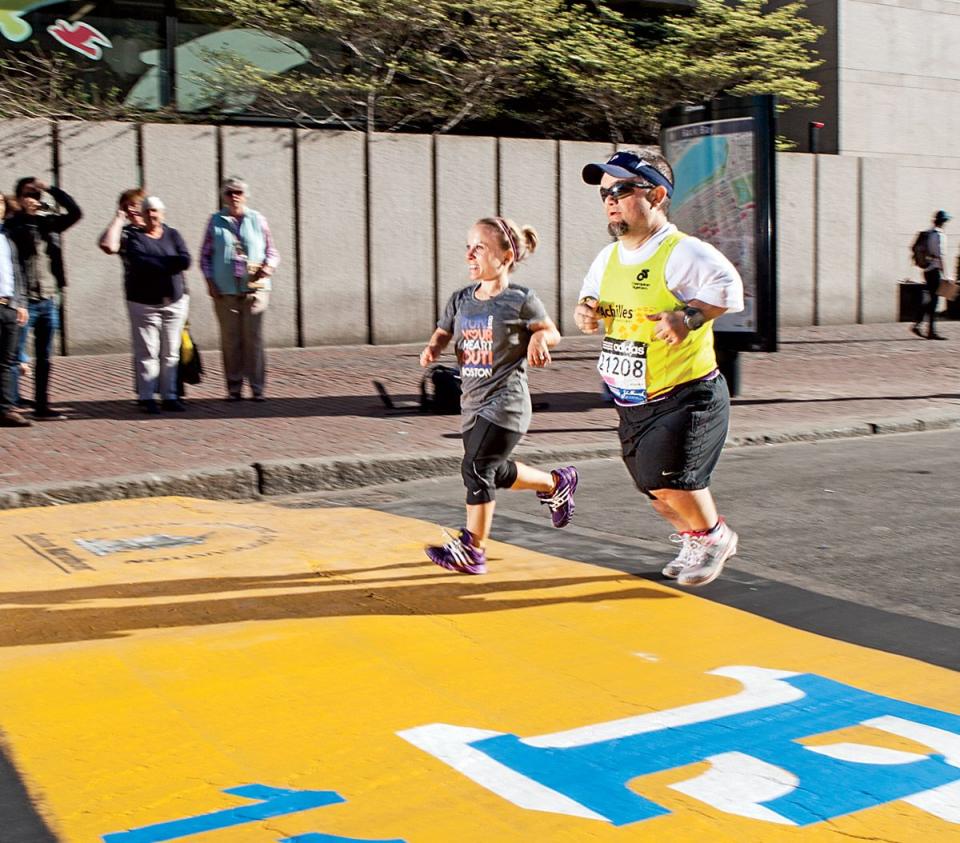
When they see each other, they hug and talk about the time that’s passed since they were last together. On the day after the marathon, Juli had two job interviews at Boston hospitals. “I’m still waiting to hear if I got one,” she tells John. He mentions that he had given a talk at a memorial service in his hometown of Salem, telling the group of 1,000 people, “Don’t be sorry I didn’t finish; be happy I started. My spirit will not be dampened, and I hope yours won’t be either.” Already, he was making plans to race again, including the NYC Marathon in the fall (he’d run it in 6:37:26). But he also had his family to consider. Sue and Owen were still shaky from being so close to the bombs; he wondered if he’d ever bring them to another race.
Tonight, though, Sue and Owen are .8 mile away, on Boylston. Blake is with them.
Juli and John begin to run. Neither starts a watch. They just run, and talk, especially about next year, when they will run Boston again. They promise each other to finish it.
As they come down Boylston, and pass the spots where their families had been waiting for them that day, the two runners get quiet. People on the street notice them, and point at them, but the two keep running.
A son waits to give his dad a medal. A husband waits to give his wife a kiss.
Two runners cross a finish line, together.
Story Update · April 21, 2016 In 2013, writer Charles Butler was standing on the Boston Marathon finish line photo bridge awaiting the arrival of Young and Windsor, when “everything changed.” The bombs went off and Butler was ordered to evacuate the bridge. He immediately set about contacting Young and Windsor. “You work on a story long enough, you’re supposed to be objective, but you’re very concerned about their welfare and not the story,” he says. Both runners were safe, as were their family members. Determined to complete their historic run, both Young and Windsor returned to Boston in 2014. Suffering the flu, Young dropped out at the 10-mile mark, but Windsor finished in 4:43, becoming the first little person to finish Boston. “I carried with me a sense of community and a need for justice shared by the city,” she wrote in an email. Boston Globe reporter David Abel had also been following Windsor’s Boston quest, and last year, he released the documentary Juli, Undaunted: Chasing History at the Boston Marathon. (Another runner with dwarfism, Danh Trang, also finished the race that year in 5:36.) Windsor gave birth to her first child, Charlie, last November, and within six weeks, ran a 5K. She’s targeting 10Ks and halfs this year. Young finally got his Boston finish last April, running 6:35 despite cold, miserable conditions. He finished out 2015 with eight triathlons and a fall marathon in which he earned his second BQ (a 5:50; the cutoff for the mobility-impaired division is six hours). He was in Beantown again this year, finishing in 6:19. And, he writes, “will continue to race each year I qualify. I think my age is going to stop me prior to anything related to my short stature.” -Nick Weldon
You Might Also Like

